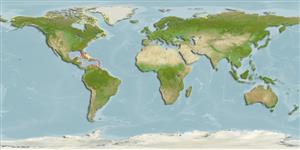Malacostraca |
Decapoda |
Palaemonidae
Environment: milieu / climate zone / depth range / distribution range
Ecology
Benthic; amphidromous (Ref. 131547); freshwater; brackish; depth range 0 - 2 m (Ref. 97531). Subtropical
Western Atlantic: USA and Canada. The Arctic.
Length at first maturity / Size / Weight / Age
Maturity: Lm 1.1, range 1 - ? cm
Coastal freshwater and estuarine (Ref. 97531).
Life cycle and mating behavior
Maturity | Reproduction | Spawning | Eggs | Fecundity | Larvae
Members of the order Decapoda are mostly gonochoric. Mating behavior: Precopulatory courtship ritual is common (through olfactory and tactile cues); usually indirect sperm transfer.
Bisby, F.A., M.A. Ruggiero, K.L. Wilson, M. Cachuela-Palacio, S.W. Kimani, Y.R. Roskov, A. Soulier-Perkins and J. van Hertum 2005 Species 2000 & ITIS Catalogue of Life: 2005 Annual Checklist. CD-ROM; Species 2000: Reading, U.K. (Ref. 19)
IUCN Red List Status
(Ref. 130435: Version 2025-1)
CITES status (Ref. 108899)
Not Evaluated
Not Evaluated
Threat to humans
Human uses
| FishSource |
Tools
More information
Trophic EcologyFood items (preys)
Diet composition
Food consumption
Predators
Population dynamicsGrowthMax. ages / sizesLength-weight rel.Length-length rel.Length-frequenciesMass conversionAbundance PhysiologyOxygen consumption
Human RelatedStamps, coins, misc.
Internet sources
Estimates based on models
Resilience
High, minimum population doubling time less than 15 months (K=1.75; tm<1).
